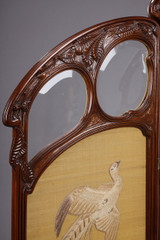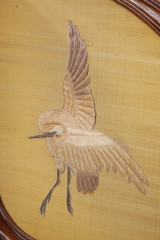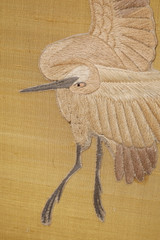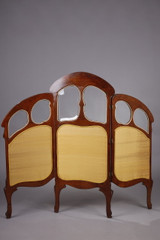Charming Art Nouveau period three-leaf folding screen or mantel screen in carved mahogany decorated with silk embroidery depicting birds. The wooden panels are carved with stylized chestnut leaves and fruit. Each leaf is adorned with a bird embroidered on Indian yellow wild silk. The upper part is openworked with six beveled glass panes. Each panel is carved with arabesques, in full Art Nouveau style. The whole unit, which can be folded, rests on four small curved legs ending in a clog. The central panel is slightly larger than the other two.
This small folding screen is signed "F. Bernard Nancy" on the central leaf.
Felix Bernard (19th-20th) was a Nancy cabinetmaker working at 6 rue de la Salpêtrière in Nancy at the end of the 19th century. His work is in the style of Émile Gallé and Louis Majorelle, making him one of the "Nancy School".
Circa: 1900
Condition report: In good condition.
Art Nouveau or the triumph of the curved line
Stemming from the romantic theories of the 19th century, Art Nouveau was based on a break with classicism and in reaction to a rapidly industrializing society. Quickly recognized as an international movement, Art Nouveau, known as "Tiffany" in the United States, "Arts and Crafts" in England, "Jugenstil" in Germany and "Stile Liberty" in Italy, made its mark in France in the early 1890s. It was Siegfried Bing, a German-born French art dealer, collector and patron of the arts, who gave the new style the name by which we know it today, when he opened an art gallery in 1895 called "L'Art nouveau". This new style imposed no rules on artists. The norms of austere academicism were pulverized, making Art Nouveau a transgressive art form at the center of which nature, women and eroticism became essential elements. Internationally, artists were united in the arabesque, organic, fluid form and reference to sensuality. In Art Nouveau, ornamentation is an integral part of the design structure.
Delivery
Europe: 500EUR
US/Canada/HK: 900EUR
Rest of the world: On quotation
- Reference :
- 3278
- Width :
- 149 (cm)
- Height :
- 133 (cm)
- Depth :
- 4 (cm)
- Period:
- 19century
- Style:
- Art nouveau
- Materials:
- Mahogany, silk











































